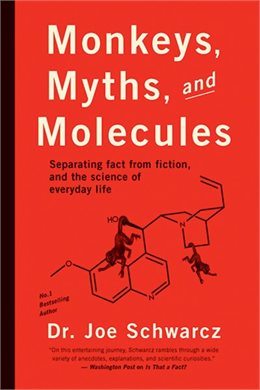“Dr. Joe” (from the title of his radio show) has done it again. He keeps putting out books faster than I can take them in; this one is titled Monkeys, Myths, and Molecules. It is packed with pithy analyses of health-related subjects that should be of particular interest to SBM readers.
Dr. Joe is Joseph Schwarcz, a chemistry professor and science popularizer based at McGill University. I’ve reviewed two of his many previous books before, Is that a Fact? here on SBM and The Right Chemistry over at Skeptic.com, as well as his free online chemistry lectures, “Food for Thought“, over at edX.org. As usual, this new book is a compendium of short (four-page) articles on a variety of subjects, written in a humorous, accessible style, and larded with intriguing trivia like where to see the largest illuminated advertising sign in the world.
If you read this book, you will:
- Learn that Mozart only had seven teeth when he died.
- Learn what was the first synthetic drug ever given to a human, and who administered it.
- Learn that Popeye really ate spinach for the vitamin A, not for the iron, and how myths about myths about spinach (no, that’s not a typo) led to ever-increasing misinformation.
- Hear the story of American military experts in WWII who had the bright idea of turning bats into weapons by attaching small incendiary devices to them. In an experiment hilariously gone wrong, the flaming bats set fire to a general’s car. (Remember that saying about military intelligence?)
- Learn the role of coprolites (fossilized animal poop) in the development of modern agriculture.
- Learn why Greek yogurt is not friendly to the environment.
Dr. Joe is a packrat for tidbits like these. I wonder where he finds them all. He seems to have a bottomless supply. One of my favorite chapters describes how a Sherlock Holmes-like pellagra sleuth ended “the scourge of the South.” Joseph Goldberger had started out studying engineering, but switched to medical school, graduated at the top of his class, and became an epidemiologist in the U.S. Public Health Service. A martyr to his cause, he caught almost every disease he studied: dengue fever, typhus, yellow fever. Then the Surgeon General asked him to look into pellagra. At the time, it was thought to be an infectious disease; patients were quarantined and treated with nonsense like castor oil, arsenic, strychnine, and spring water baths. Goldberger noticed that pellagra was rampant among patients in mental hospitals and orphanages, but that it didn’t affect the staff; so he figured that pretty much ruled out infection. He noticed that the patients’ diet differed from the staff’s, so he hypothesized that the cause might be something dietary. He put his hypothesis to the test. In an orphanage, he kept one ward on the usual diet of grits, corn bread, collard greens, fatback and molasses; while another ward additionally got milk, meat, eggs, and fresh vegetables. Pellagra was wiped out in the treated group but unchanged in the control group. He further ruled out infection by holding “filth parties” where the skin, snot, urine, and feces of pellagra patients were mixed into dough and swallowed by volunteers; they didn’t enjoy it, but they didn’t get pellagra. Then he experimented on a group of prisoners and was able to give them pellagra by limiting their diet. (Research ethics were different in his day.)
He went on to show that pellagra could be reversed by brewer’s yeast, but he didn’t know why. Later, other researchers extracted niacin (vitamin B3) from liver and demonstrated that it would cure pellagra. Interestingly, the liver can make niacin from the amino acid tryptophan, but conversion is so slow and inefficient that unless there is a large amount of protein in the diet, the liver can’t produce enough to meet the body’s needs. When niacin was added to bread in 1938, the incidence of pellagra dropped dramatically.
People in Mexico lived mainly on corn; why didn’t they get pellagra? Scientists finally solved the puzzle. There is niacin in corn, but it is bound to other molecules and is unavailable to the body. Fortunately, the Mexican practice of soaking corn in a lime solution (nixtamalization) releases the bound niacin.
Niacin is a fascinating detective story that has the added virtue of being true. It’s a great example of how the scientific method operates to improve our understanding of the world and how it contributes to human welfare. As the comic says, Science. It Works, Bitches.
Pippi Longstocking, Thomas Edison, Houdini, Montezuma, and the Queen of Sheba make an appearance in these pages, along with a lot of other celebrities past and present. Dr. Joe skewers food myths, opposition to GMOs, Dr. Oz, and Vani Hari, aka the Food Babe. He gives us the straight dope on a wide variety of subjects including ripe bananas, cholesterol, sugar, E. coli, BPA, the connection between armpit cheese and mosquitos, apple peels, chewing gum, the “natural” fallacy, nanosilver, smart meters, cat pheromones, malaria, Norwalk virus, cobwebs in the nose, and many others.
This is just a taste from Dr. Joe’s latest banquet of educational and entertaining snacks. I hope it will whet your appetite.

